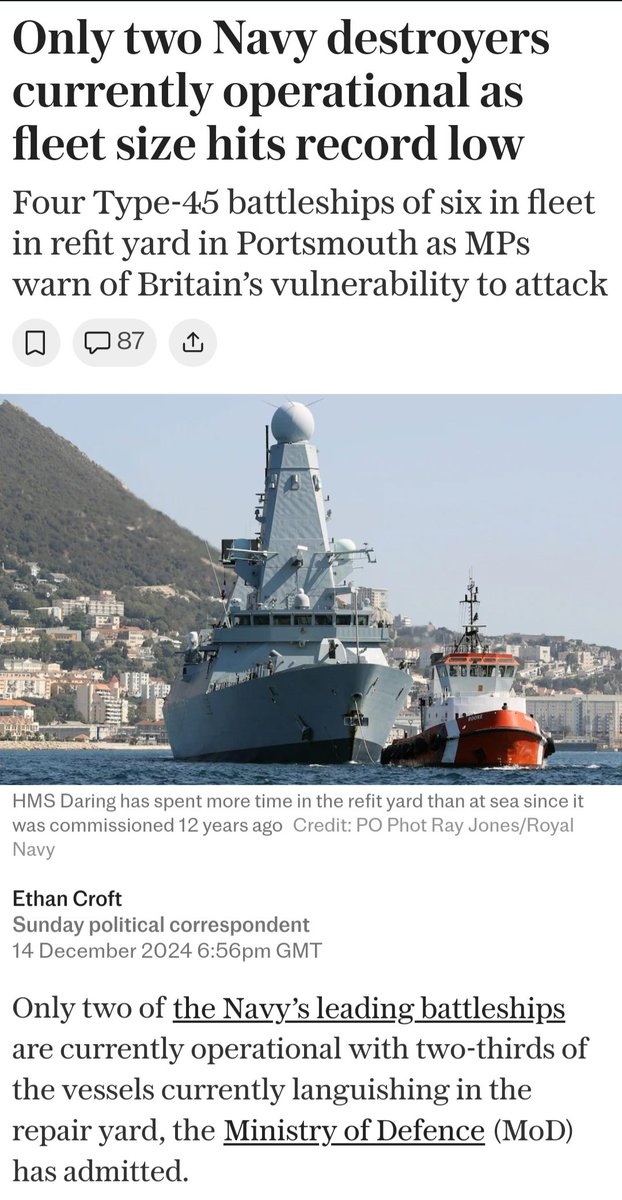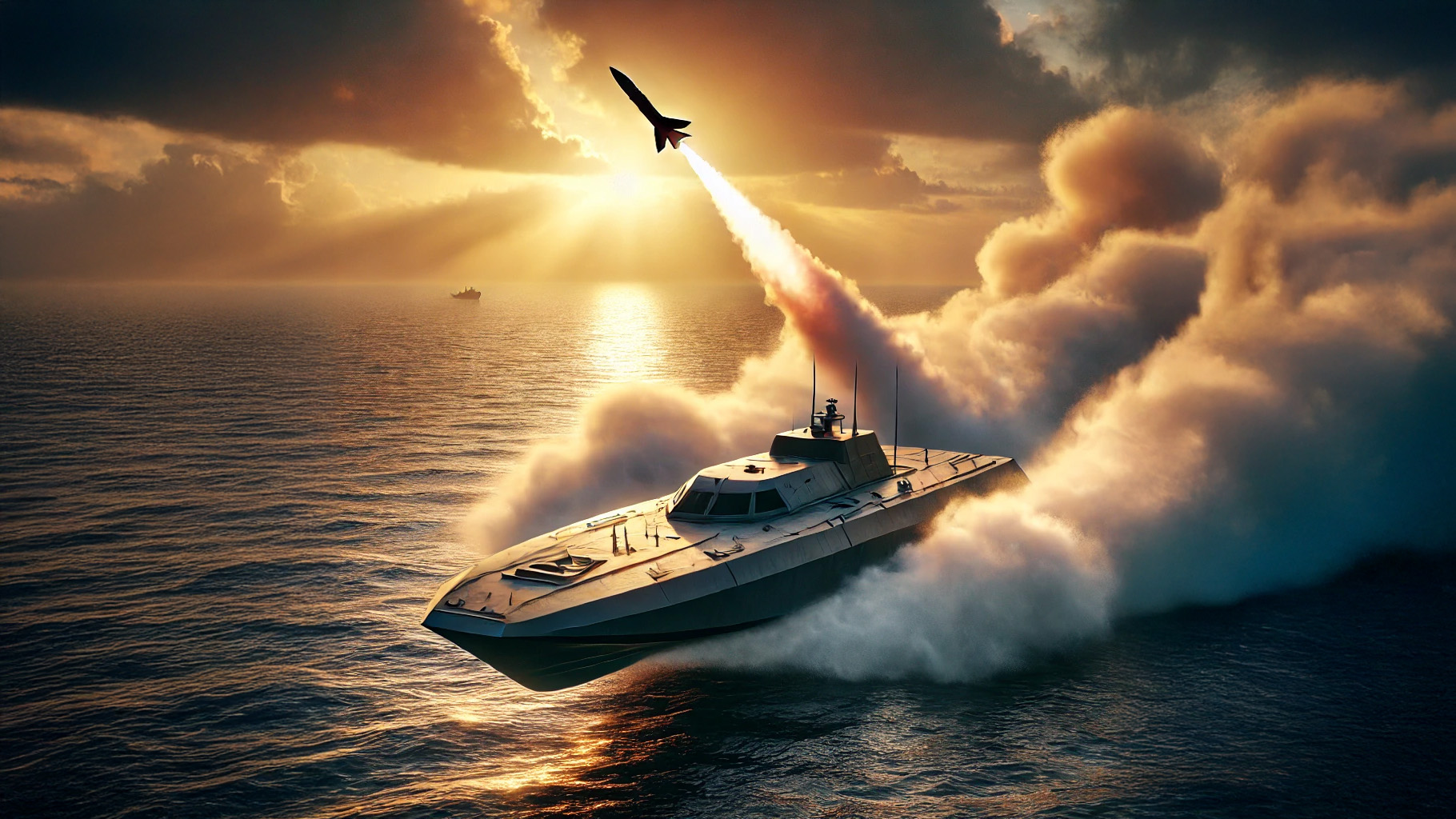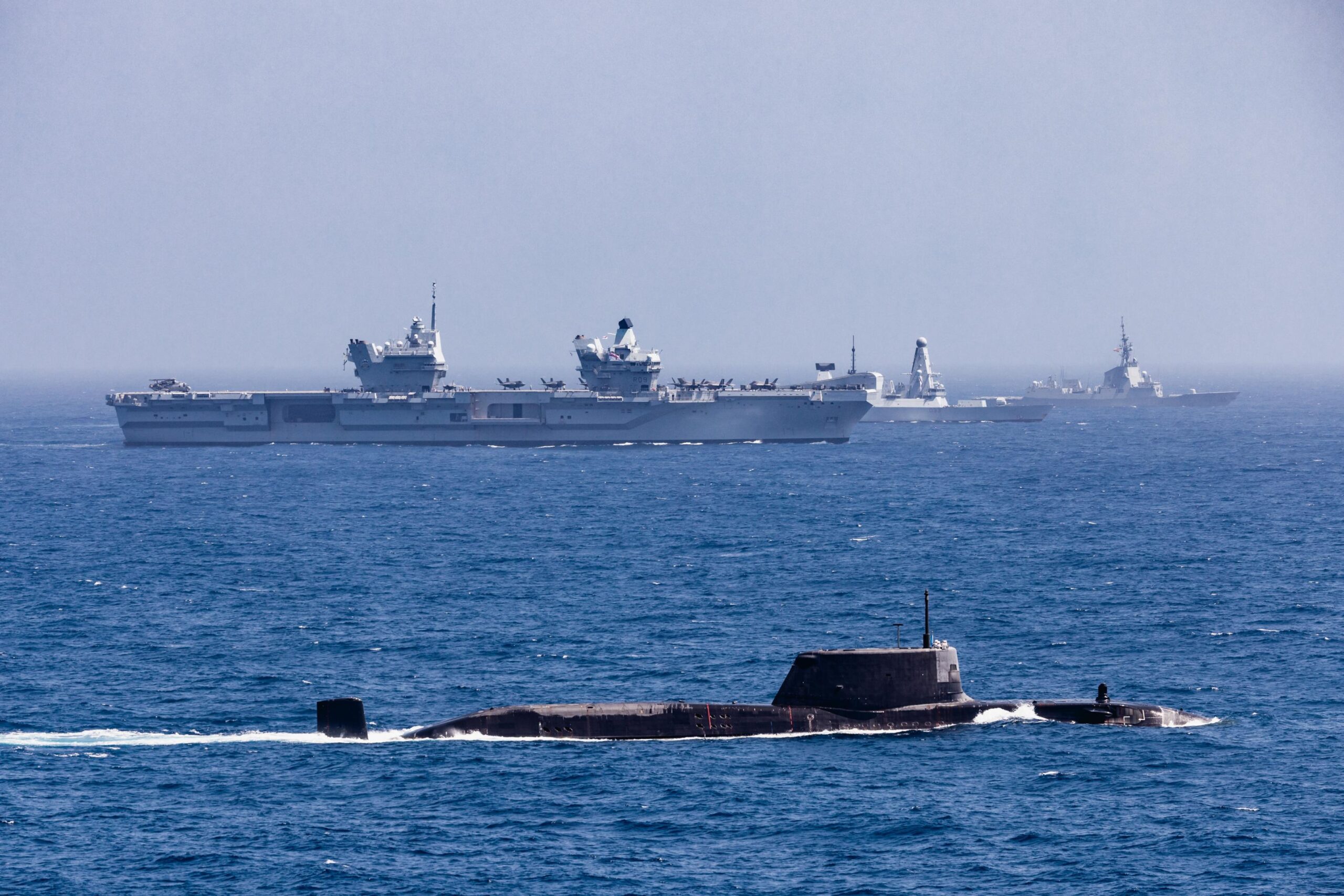The MOD is retiring a number of capabilities to save money. In the biggest cuts to the RN in nearly 20 years, 5 warships, over 100k tonnes of shipping, are being scrapped along with 32 helicopters and dozens of drones. Long thread on why this isn't as bad as some may think. /1
The context is that the MOD is financially strained due to inflation, cost growth, rise in operating costs and shortfalls of people. Elderly equipment is being run on far longer than planned and there is not enough money to do everything that MOD wants to do. /2
This is a problem whichever Party was in Government would need to tackle head on. The Defence budget was not able to cope in year, or over years ahead with the pressures it ahead without either a massive budget rise or significant capability cuts, regardless of who was in office.
How bad is it? For the RN its actually not that bad. NORTHUMBERLAND was beyond economic repair following serious structural issues ("rotten keel") - that she is afloat and not on the seabed is arguably a minor miracle if this is true. Its probably the biggest loss to the RN.
But its also realistic - we cannot send ships to sea that have broken keels, nor does it make sense to spend money we don't have fixing elderly ships far past their design life for a handful of years service. This is a lesson that T23 run on is proving painful and expensive. /5
The WAVE class have been in reserve for years, at least one for almost a decade. They were due to retire in 3 years. The RFA has no crew to operate them or put them to sea, and this situation is not going to change any time soon. These ships were never going to sea again./6
This is a sad loss, but without the sailors, the ships were effectively useless. This speaks to the importance of ensuring that there are enough RFA sailors in the force, not just platforms - an issue that has been 14 years in the making .
The ALBION class may seem a loss, but in fact the UK, and wider NATO is moving away from the amphibious operations they were built for. The UK has long dispensed with the wider kit needed to do a full brigade strength landing, and these ships were hulls in search of a role. /7
If you look at their use for much of last decade, they rarely carried out the amphibious role, and were used as C2 platforms or for littoral ops in landing craft. The loss of OCEAN and wider RFA's and 3 Cdo Bde assets meant the UK capability was minimal for wider amphib work./8
The RN is taking a few years gap, but it was getting out of the LPD game anyway. Look at MRSS and you'll see it is a very different design, in the same way that other NATO allies are also moving in this direction. The method of operations has changed, and with it the need for LPD
The loss of Puma and Chinook is sad, but reflects reality of two elderly forces, both at limits of their design life (older Chinooks are 40+ yrs old). There are replacements on order for both forces. The gap is short and already has replacements funded.
Similarly, Watchkeeper is of mixed value - Ukraine is showing us a fleet of expensive drones with finite capability is not hugely helpful - what is needed is lots of cheaper drones that are eminently expendable and a much faster upgrade pathway to remain relevant.
So what is the impact? For the RN there is no loss in immediate fighting power. All these ships were in reserve/refit and none are seagoing. There is no impact on day to day fleet operations. This frees up sailors and resources for gaps elsewhere of higher importance.
They couldn't be reactivated in time for a conflict, nor is there the people in the system to crew them. Public money is being spent maintaining kit the RN has spent years wanting to dispose of (LPDs) rather than on the assets it needs to fight tonight.
Counting kit for the sake of it isn't sensible. These ships were not in any way a meaningful capability except on the pages of Janes Fighting Ships. The RN needs to focus on other roles, rather than cling to historical ones we no longer intend to carry out in the same way.
The cuts are painful, but the pitch is that new kit is coming - a line that many will be familiar with. Keeping the faith that these replacements emerge will be hard for some - a new dawn has often been promised but is not yet here - many may question if it will ever arrive.
For the UK the challenge is to show that there is a plan, that it is funded and that the kit promised (H145 / Type 26 / future Chinook) remains committed and enters service as planned. Delays will make the gap larger and more painful to absorb.
From a narrative perspective, it is a hard sell - one could argue that at a time when NATO is rearming, the UK is disarming. Showing how this isn't the case, that this is about investment in NATO capability and long term refocusing on the European theatre is key here.
The context is that the MOD is financially strained due to inflation, cost growth, rise in operating costs and shortfalls of people. Elderly equipment is being run on far longer than planned and there is not enough money to do everything that MOD wants to do. /2
This is a problem whichever Party was in Government would need to tackle head on. The Defence budget was not able to cope in year, or over years ahead with the pressures it ahead without either a massive budget rise or significant capability cuts, regardless of who was in office.
How bad is it? For the RN its actually not that bad. NORTHUMBERLAND was beyond economic repair following serious structural issues ("rotten keel") - that she is afloat and not on the seabed is arguably a minor miracle if this is true. Its probably the biggest loss to the RN.
But its also realistic - we cannot send ships to sea that have broken keels, nor does it make sense to spend money we don't have fixing elderly ships far past their design life for a handful of years service. This is a lesson that T23 run on is proving painful and expensive. /5
The WAVE class have been in reserve for years, at least one for almost a decade. They were due to retire in 3 years. The RFA has no crew to operate them or put them to sea, and this situation is not going to change any time soon. These ships were never going to sea again./6
This is a sad loss, but without the sailors, the ships were effectively useless. This speaks to the importance of ensuring that there are enough RFA sailors in the force, not just platforms - an issue that has been 14 years in the making .
The ALBION class may seem a loss, but in fact the UK, and wider NATO is moving away from the amphibious operations they were built for. The UK has long dispensed with the wider kit needed to do a full brigade strength landing, and these ships were hulls in search of a role. /7
If you look at their use for much of last decade, they rarely carried out the amphibious role, and were used as C2 platforms or for littoral ops in landing craft. The loss of OCEAN and wider RFA's and 3 Cdo Bde assets meant the UK capability was minimal for wider amphib work./8
The RN is taking a few years gap, but it was getting out of the LPD game anyway. Look at MRSS and you'll see it is a very different design, in the same way that other NATO allies are also moving in this direction. The method of operations has changed, and with it the need for LPD
The loss of Puma and Chinook is sad, but reflects reality of two elderly forces, both at limits of their design life (older Chinooks are 40+ yrs old). There are replacements on order for both forces. The gap is short and already has replacements funded.
Similarly, Watchkeeper is of mixed value - Ukraine is showing us a fleet of expensive drones with finite capability is not hugely helpful - what is needed is lots of cheaper drones that are eminently expendable and a much faster upgrade pathway to remain relevant.
So what is the impact? For the RN there is no loss in immediate fighting power. All these ships were in reserve/refit and none are seagoing. There is no impact on day to day fleet operations. This frees up sailors and resources for gaps elsewhere of higher importance.
They couldn't be reactivated in time for a conflict, nor is there the people in the system to crew them. Public money is being spent maintaining kit the RN has spent years wanting to dispose of (LPDs) rather than on the assets it needs to fight tonight.
Counting kit for the sake of it isn't sensible. These ships were not in any way a meaningful capability except on the pages of Janes Fighting Ships. The RN needs to focus on other roles, rather than cling to historical ones we no longer intend to carry out in the same way.
The cuts are painful, but the pitch is that new kit is coming - a line that many will be familiar with. Keeping the faith that these replacements emerge will be hard for some - a new dawn has often been promised but is not yet here - many may question if it will ever arrive.
For the UK the challenge is to show that there is a plan, that it is funded and that the kit promised (H145 / Type 26 / future Chinook) remains committed and enters service as planned. Delays will make the gap larger and more painful to absorb.
From a narrative perspective, it is a hard sell - one could argue that at a time when NATO is rearming, the UK is disarming. Showing how this isn't the case, that this is about investment in NATO capability and long term refocusing on the European theatre is key here.














